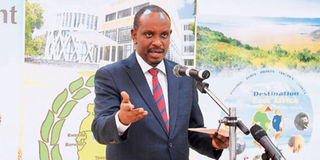EAC keen on single customs territory

“I look forward to its implementation beginning 2014. We have seen significant and sustained removal of non-tariff barriers to trade,”
Dr Richard Sezibera, East African Community Secretary General
What you need to know:
- EAC secretary general Richard Sezibera said that was among his five priorities when he joined the regional organisation in 2011 and that he hoped its fruition was just around the corner. “I look forward to its implementation beginning 2014.
Arusha. The East African Community (EAC) believes that the implementation of the single customs territory framework would begin this year as directed by the Heads of State Summit recently.
EAC secretary general Richard Sezibera said that was among his five priorities when he joined the regional organisation in 2011 and that he hoped its fruition was just around the corner. “I look forward to its implementation beginning 2014. We have seen significant and sustained removal of non-tariff barriers to trade — and the results thereof are beginning to be felt by East Africans,” he said in his New Year message sent to the media houses in the region.
During its 15th Ordinary Summit in Kampala, Uganda, on November 30 last year, the EAC leaders directed that the single customs territory start on January 1 and be operationalised by June 2014.
Earlier the report on the framework on the operationalisation, which was finalised recently, was presented and adopted by the EAC Council of Ministers, the policy organ of the Community.
Dr Sezibera said with the blessings of the summit, he was confident that the new customs arrangement would be implemented by all the partner states without unnecessary delay.
The single customs territory aims at liberalising trade in the region as goods would circulate freely within the terrirtory which is not the case at present.
Analysts believe the EAC still suffers from internal controls which have hindered the region from getting full benefits of a customs union. Under the single customs territory, the bloc will have a common legal framework that would ensure free circulation of goods with minimal or no border controls.
Implementation of the framework would also lead to the harmonisation of standards from goods moved through the territory, inter-connected payment system and collection of customs duty at the first point of entry. The study on single customs territory started in September 2011 and was undertaken by Adam Smith International and MA Consulting Group.
It will lead the region to realise an appropriate institutional and legal framework for unified customs services. Dr Sezibera added that the free movement of persons and labour provisions of the Common Market Protocol will be boosted by an agreement on the use of identity cards as travel documents within EAC by Burundi, Kenya, Rwanda, and Uganda beginning this year. “This will also be the year we finalise all preparations and procure the next generation internationalised East African passport which will be issued in 2015,” he explained.
These are exciting times. Progress has been recorded on mutual recognition of qualifications in East Africa and preparations for turning the region into a single higher education area by 2015 are gaining momentum.




